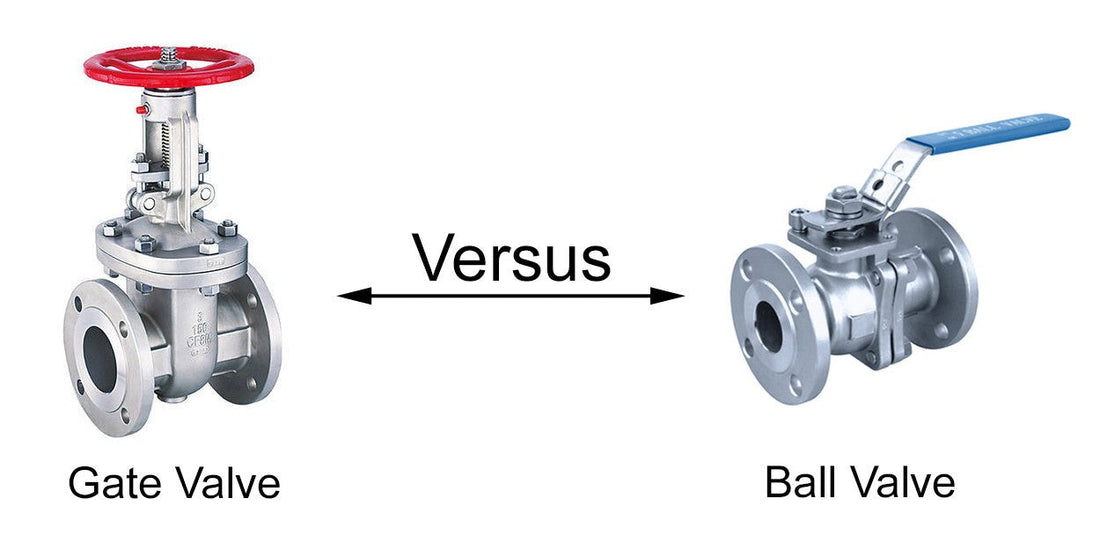Valve selection is a core decision that affects performance, durability, and cost. Two of the most common types of on/off valves used in plumbing are gate valves and ball valves. While both serve similar purposes, their design, functionality, and ideal use cases differ significantly.
Understanding the difference between gate valves vs ball valves will help you make the right choice. Let’s break down how these valves work, when to use them, and which one offers the most value for your system.
What Is a Gate Valve?
A gate valve controls flow by raising or lowering a wedge-shaped gate (or disc) inside the valve body. When fully open, the gate retracts entirely, allowing water to flow through unobstructed. When fully closed, the gate seals off the passage to stop the flow completely.
Key Characteristics:
-
Designed for full open or full closed use (not throttling)
-
Operated using a threaded stem and handwheel
-
Typically slower to operate than ball valves
-
Available in a range of sizes and materials
Common Use Cases:
Gate valves are frequently found in:
-
Water supply systems
-
Industrial facilities
-
Municipal plumbing infrastructure
-
Older home plumbing systems
Gate valves excel in situations where valves are left either open or closed for long periods, such as main shutoff lines. However, they are not ideal for applications requiring frequent operation.
What Is a Ball Valve?
A ball valve uses a rotating ball with a hole (or "bore") drilled through it. When the handle is turned 90 degrees, the hole aligns with the pipe to allow flow — or rotates to block it entirely.
Key Characteristics:
-
Quick quarter-turn operation
-
Offers a tight, reliable seal (ideal for gas and liquids)
-
Durable and typically maintenance-free
-
Available in two-way and multi-port configurations
Common Use Cases:
Ball valves are ideal for:
-
Residential plumbing systems
-
HVAC applications
-
Oil and gas pipelines
-
Irrigation and water treatment systems
-
Manufacturing and food processing industries
Because of their fast operation and superior sealing ability, ball valves are now standard in modern homes and commercial systems that require frequent or precise flow control.
Gate Valves vs Ball Valves: Side-by-Side Comparison
Here’s how these two valve types stack up across key categories:
|
Feature |
Gate Valve |
Ball Valve |
|
Operation |
Multi-turn (slower) |
Quarter-turn (fast) |
|
Seal Type |
Less tight, may leak over time |
Tight seal, reliable shutoff |
|
Flow Control |
Full open/full close only |
Full shutoff with quick response |
|
Maintenance |
Prone to corrosion, may require upkeep |
Low maintenance, often replace instead of repair |
|
Durability |
Can degrade in high-cycle use |
Longer-lasting under frequent use |
|
Size and Space |
Compact body but taller stem |
Compact overall, may require clearance to turn |
|
Cost |
Lower upfront cost |
Higher initial cost but longer lifespan |
Which Valve Is Right for Your Plumbing System?
Choosing between a gate valve or a ball valve depends on your application, performance expectations, and budget.
Choose a Gate Valve If:
-
You need an economical option for occasional operation
-
You’re working on a legacy system that already uses gate valves
-
Space for a lever handle is limited
Choose a Ball Valve If:
-
You need fast on/off control
-
A tight, reliable seal is critical (e.g., gas or pressurized systems)
-
Durability and low maintenance are top priorities
-
You want a future-ready system with minimal downtime
For modern plumbing needs ball valves are often the superior long-term investment. In fact, we carry a wide selection of Ball Valves and Gate Valves at Voomi Supply to meet your specific application and sizing needs.
Finding the Right Fit at Voomi Supply
At Voomi Supply, we understand that even the smallest plumbing components play a big role in system performance. That’s why we offer one of the widest online selections of gate valves, ball valves, and other hard-to-find plumbing parts. Our team is here to help professionals and DIYers alike find the right valve for the job — fast. Plus, with our efficient shipping and customer-first support, you can count on Voomi for the quality and service your projects deserve.
In the gate valves vs ball valves comparison, there’s no one answer — only the right valve for your system’s unique needs. Gate valves are reliable in large-scale systems where operation is infrequent, while ball valves deliver fast, leak-proof performance ideal for modern plumbing systems.


